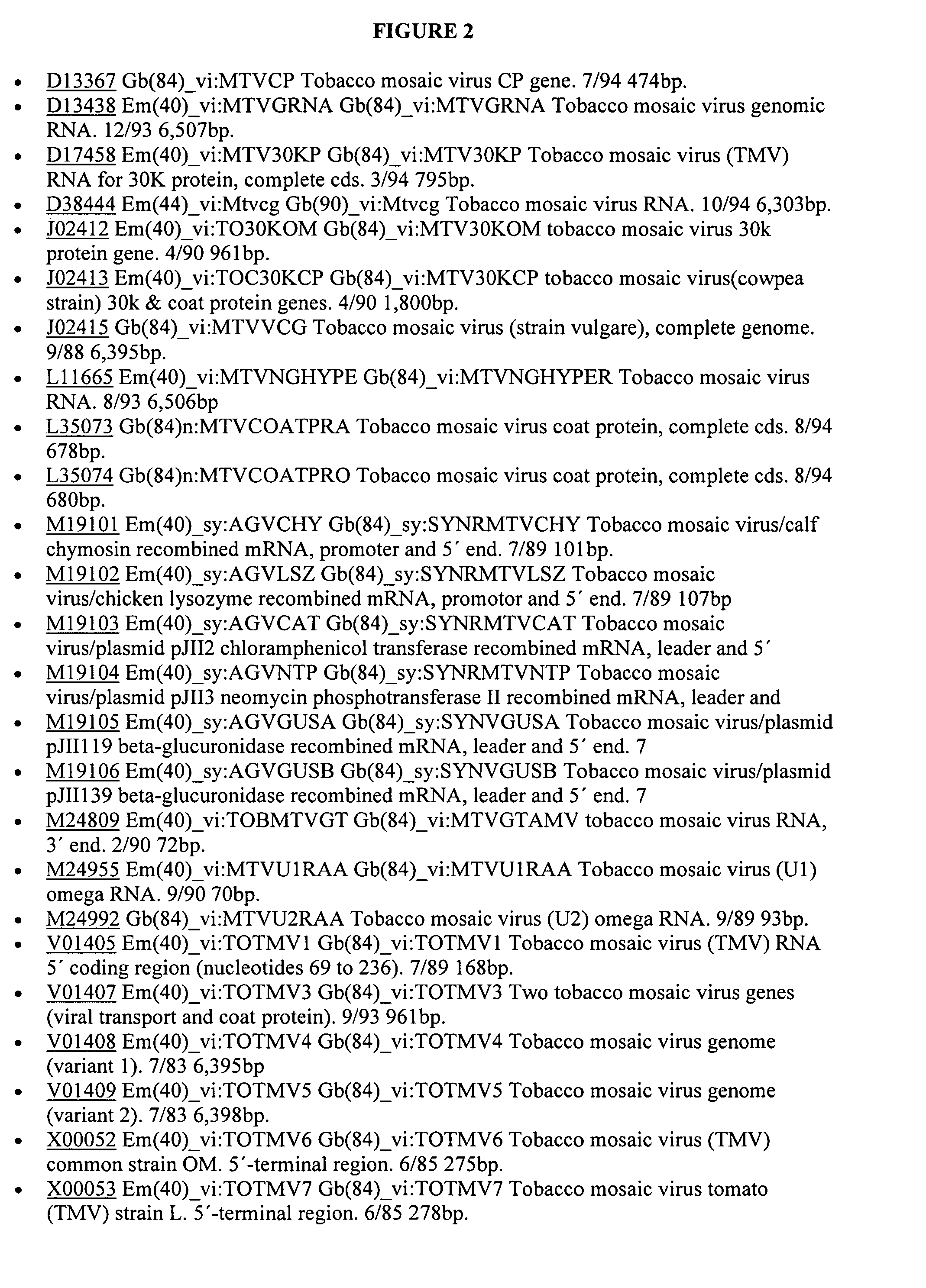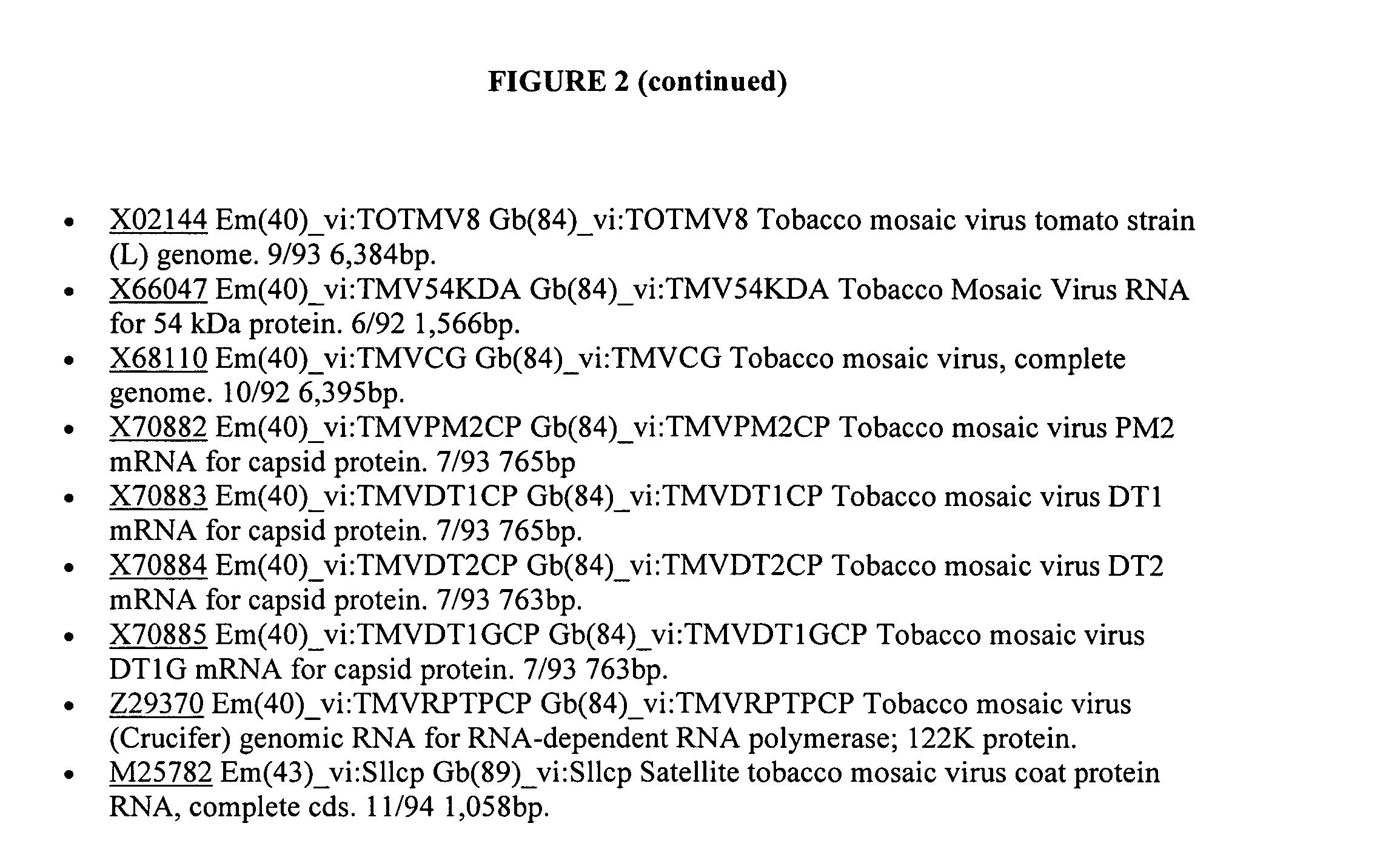System for expression of genes in plants
a gene expression and plant technology, applied in the field of plant gene expression system, can solve the problems of significant environmental risks and plant viruses that do not express transgenes at desired levels, and achieve the effects of reducing or eliminating risks, facilitating more flexibility in the cultivation of recipient plants, and improving the environmental safety of gene expression in plants
- Summary
- Abstract
- Description
- Claims
- Application Information
AI Technical Summary
Benefits of technology
Problems solved by technology
Method used
Image
Examples
example 1
Construction of Inventive Vectors
[0096] We have prepared vector systems that include components of two heterologous plant viruses in order to achieve a system that readily infects a wide range of plant types and yet poses little or no risk of infectious spread. In certain preferred embodiments, this system includes components from Alfalfa Mosaic Virus (AlMV) and Tobacco Mosaic Virus (TMV).
[0097] AlMV is an Alfamovirus, closely related to the Ilarvirus group and is a member of the Bromoviridae family. The genome of AlMV consists of three positive-sense RNAs (RNAs 1-3) (See FIG. 4, which presents accession codes for a variety of AlMV genome sequences). RNAs 1 and 2 encode replicase proteins P 1 and P2, respectively; RNA3 encodes the cell-to-cell movement protein P3. A subgenomic RNA, RNA4, is synthesized from RNA3. This subgenomic RNA4 encodes the viral coat protein (CP). CP participates in viral genome activation to initiate infection, RNA replication, viral assembly, viral RNA sta...
example 2
Expression of a Polynucleotide Encoding Human Growth Hormone
[0106]FIG. 8 shows two TMV-based vectors, 125C and D4, that were engineered to accept insertion of a polynucleotide of interest, following insertion of the polynucleotide (indicated as “foreign gene”). 125C includes TMV coat protein sequences (i.e. sequences extending downstream from nucleotide 5757 of the TMV genome) that contain a cis element that may be required for optimal replication. We inserted the gene for human growth hormone (hGH) into each of these vectors between the Pac1 and Xho1 sites. An AUG was introduced in the 5′ primer used to amplify the gene from a plasmid, and the amino acids KDEL were introduced at the 3′ end of the coding sequence in order to enhance translation due to retention in the ER. HGH was cloned with and without its native leader sequence; hGH2 lacks the leader and hGH4 includes the leader.
[0107] Primer SR22 (5′-CCG TTAATTAATG TTC CCA ACT ATT CCA) was used to clone hGH without its leader, ...
example 3
Transient Expression of a Human Insulin Transgene
[0113] We have made constructs to express insulin and proinsulin in plants using our plant virus-based transient expression vectors D4 and 125C. The following primers were used to clone proinsulin into 125C and D4, relying on Pac1 and Xho1 sites for cloning, and adding KDEL at the 3′, end of each peptide:
[0114] 1) Pac1 site at 5′ end of insulin ORF (B peptide):
SR305′-ccg tta att aatg ttt gtt aat caa cat-3′
[0115] 2) Xho1 site at 3′ end of A peptide with KDEL
SR315′-cgg ctc gag tca gag ttc atc ttt gtt acagta gtt ctc aag-3′
PUM
| Property | Measurement | Unit |
|---|---|---|
| length | aaaaa | aaaaa |
| volume | aaaaa | aaaaa |
| volume | aaaaa | aaaaa |
Abstract
Description
Claims
Application Information
 Login to View More
Login to View More - R&D
- Intellectual Property
- Life Sciences
- Materials
- Tech Scout
- Unparalleled Data Quality
- Higher Quality Content
- 60% Fewer Hallucinations
Browse by: Latest US Patents, China's latest patents, Technical Efficacy Thesaurus, Application Domain, Technology Topic, Popular Technical Reports.
© 2025 PatSnap. All rights reserved.Legal|Privacy policy|Modern Slavery Act Transparency Statement|Sitemap|About US| Contact US: help@patsnap.com



